Articles
- Page Path
- HOME > J Korean Acad Nurs > Volume 45(2); 2015 > Article
-
Review Article
- Effects of Cognitive Behavioral Therapy on Attention Deficit Hyperactivity Disorder among School-aged Children in Korea: A Meta-Analysis
- Wan-Ju Park, Shin-Jeong Park, Sung-Dong Hwang
-
Journal of Korean Academy of Nursing 2015;45(2):169-182.
DOI: https://doi.org/10.4040/jkan.2015.45.2.169
Published online: April 30, 2015
1College of Nursing·Research Institute of Nursing Science, Kyungpook National University, Daegu, Korea.
2College of Social Sciences, Kyungpook National University, Daegu, Korea.
- Address reprint requests to: Hwang, Sung-Dong. College of Social Sciences, Kyungpook National University, 80 Daehak-ro, Buk-gu, Daegu 702-701, Korea. Tel: +82-53-950-5253, Fax: +82-53-950-6251, sungdong@knu.ac.kr
© 2015 Korean Society of Nursing Science
This is an Open Access article distributed under the terms of the Creative Commons Attribution NoDerivs License. (http://creativecommons.org/licenses/by-nd/4.0/) If the original work is properly cited and retained without any modification or reproduction, it can be used and re-distributed in any format and medium.
Abstract
-
Purpose
- This study was a meta-analysis designed to identify effects of Cognitive Behavioral Therapy (CBT) interventions in alleviating main symptoms of Attention Deficit Hyperactivity Disorder (ADHD) among school-aged children in Korea.
-
Methods
- Examination of several databases including Research Information Sharing Service, Korean Studies Information Service System, Data Base Periodical Information Academic and hand-searched article references, resulted in identification of 1,298 studies done between 2000 and 2013 of which 21 met the inclusion criteria. Comprehensive Meta-Analysis version 2.0 was used to analyze effect sizes, explore possible causes of heterogeneity, and check publication bias with a funnel plot and its trim-and-fill analysis.
-
Results
- Overall effect size of CBT intervention was large (g=1.08) along with each outcome of self-control (g=1.26), lack of attention (g=1.02), social skills (g=0.92), and hyperactivity (g=0.92). For heterogeneity, moderator analysis was performed, but no significant differences were found between the RCT (Randomized Controlled Trials) group and the NRCT (Non RCT) group. Also, meta-regression was performed using sample size, number of sessions, and length of session as predictors, but no statistically significant moderators were found. Finally, a funnel plot along with trim-and-fill analysis was produced to check for publication bias, but no significant bias was detected.
-
Conclusion
- Based on these findings, there is clear evidence that CBT intervention has significant positive effects on the main symptoms of school-aged children suffering ADHD. Further research is needed to target diverse age groups with ADHD along with more RCT studies to improve the effectiveness of the CBT intervention.
This study was supported by Basic Science Research Program through the National Research Foundation of Korea (NRF) funded by the Ministry of Education and Technology (No.: NRF-20110022764).
This research was supported by Kyungpook National University Research Fund, 2013.
- 1. Park HJ, Heo JY, Kim YH, Song HJ. Development and effects of a combined program of cognitive enhancement - social skills - parents training program for ADHD children and their parents. J Emot Behav Disord. 2011;27(3):25–58.
- 2. Biederman J, Kwon A, Aleardi M, Chouinard VA, Marino T, Cole H, et al. Absence of gender effects on attention deficit hyperactivity disorder: Findings in nonreferred subjects. Am J Psychiatry. 2005;162(6):1083–1089. ArticlePubMed
- 3. Health Insurance Review & Assessment Service. Children and adolescent attention deficit hyperactivity disorder: Eight out of ten people [Internet]. Seoul, Author. 2012;cited 2012 May 10. Available from: http://www.hira.or.kr/co/searchCms.do?catid=14hi6_2&collection=cms&startCount=0&pgmid=HIRAA020041000000&field=subject&search_word=%EC%86%8C%EC%95%84%C2%B7%EC%B2%AD%EC%86%8C%EB%85%84+%EC%A3%BC%EC%9D%98%EB%A0%A5%EA%B2%B0%ED%95%8D%EC%9E%A5%EC%95%A0
- 4. Kim IH. Effect of the group art therapy in children with attention-deficit hyperactivity disorder (ADHD). J Korean Acad Psychiatr Ment Health Nurs. 2006;15(2):152–160.ArticlePDF
- 5. Oh WO, Park ES. Parenting experiences of parents of children with ADHD: Approaching the normal. J Korean Acad Nurs. 2007;37(1):91–104.ArticlePDF
- 6. Kim IH. The effect of social skills training with attention-deficit hyperactivity disorder (ADHD). J Korean Acad Psychiatr Ment Health Nurs. 2007;16(4):420–428.ArticlePDF
- 7. Lee DH, Kim MS, Song YJ, Kwon BM. An exploratory review of literature on peer relationship of children with ADHD. Korean J Couns Psychother. 2013;25(3):643–672.
- 8. Park SH, Go H. A case study applying both cognitive behavioral therapy and art psychotherapy to an ADHD child. J Arts Psychother. 2010;6(2):79–99.
- 9. Seo JY, Park WJ. The meta analysis of trends and the effects of nonpharmacological intervention for school aged ADHD children. J Korean Acad Psychiatr Ment Health Nurs. 2010;19(2):117–132.Article
- 10. Kim Y, Seo S. Current trends and issues in non-medication interventions to address the academic impairment of children and adolescents with ADHD. Korean J Sch Psychol. 2011;8(1):79–110.Article
- 11. Song CJ, Koo BH, Bai DS. Item selection and analysis for the development of Korean attention deficit hyperactivity disorder rating scale. J Emot Behav Disord. 2006;22(1):1–26.
- 12. Higgins JPT, Green S. In: Cochrane handbook for systematic reviews of interventions version 5.1.0 [Internet]. London, UK, The Cochrane Collaboration. 2011;cited 2011 March 20. Available from: http://handbook.cochrane.org/
- 13. Cully JA, Teten AL. A therapist's guide to brief cognitive behavioral therapy. Houston, TX: South Central Mental Illness Research, Education, and Clinical Center; 2008.
- 14. Scottish Intercollegiate Guidelines Network. SIGN 50: A guideline developer's handbook [Internet]. Edinburgh, UK, Author. 2011;cited 2012 May 29. Available from: http://www.sign.ac.uk/guidelines/fulltext/50/index.html
- 15. Borenstein M, Hedges LV, Higgins JPT, Rothstein HR. Introduction to meta-analysis. West Sussex, UK: John Wiley & Sons, Ltd.; 2009.
- 16. Cohen J. Statistical power analysis for the behavioral sciences. 2nd ed. Hillsdale, NJ: Lawrence Erlbaum Associates; 1988.
- 17. Rosenthal R, Rubin DB. A simple, general purpose display of magnitude of experimental effect. J Educ Psychol. 1982;74(2):166–169.Article
- 18. Littell JH, Corcoran J, Pillai V. Systematic reviews and meta-analysis. New York, NY: Oxford University Press; 2008.
- 19. Egger M, Smith GD, Schneider M, Minder C. Bias in meta-analysis detected by a simple, graphical test. BMJ. 1997;315(7109):629–634.ArticlePubMedPMC
- 20. Duval S, Tweedie R. A nonparametric "trim and fill" method of accounting for publication bias in meta-analysis. J Am Stat Assoc. 2000;95(449):89–98. Article
- 21. Miranda A, Presentación MJ, Soriano M. Effectiveness of a school-based multicomponent program for the treatment of children with ADHD. J Learn Disabil. 2002;35(6):546–562.ArticlePubMedPDF
- 22. Kang SH, Hong JM, Baek YH. The effect of group art activity program on impulsiveness and self-control of children with attention deficit hyperactivity. Korean J Art Ther. 2006;13(1):23–48.
- 23. Lee Y. A meta-analysis of the effect of group counseling programs on ADHD children's behavior change [master's thesis]. Cheongju, Korea National University of Education. 2006.
- 24. Van der Oord S, Prins PJ, Oosterlaan J, Emmelkamp PM. Efficacy of methylphenidate, psychosocial treatments and their combination in school-aged children with ADHD: A meta-analysis. Clin Psychol Rev. 2008;28(5):783–800. ArticlePubMed
- 25. Ghafoori B, Tracz SM. Effectiveness of cognitive-behavioral therapy in reducing classroom disruptive behaviors: A meta-analysis. Washington, DC: Education Resources Information Center; 2001.Report No.: ERIC Document Reproduction Service No. ED 457182.
- 26. Toplak ME, Connors L, Shuster J, Knezevic B, Parks S. Review of cognitive, cognitive-behavioral, and neural-based interventions for attention-deficit/hyperactivity disorder (ADHD). Clin Psychol Rev. 2008;28(5):801–823. ArticlePubMed
- 27. Fabiano GA, Pelham WE Jr, Coles EK, Gnagy EM, Chronis-Tuscano A, O'Connor BC. A meta-analysis of behavioral treatments for attention-deficit/hyperactivity disorder. Clin Psychol Rev. 2009;29(2):129–140. ArticlePubMed
- 28. Kim JU, Cheon SM, Hwang HJ. A comparison of the effect of cognitive/behavioral NLP group counseling on behavior and school life adjustment of ADHD children. Korean J Couns. 2005;6(3):777–788.
- 29. Sohn JN. The effects of the peer suicide prevention gatekeeper program for middle school students. J Korean Acad Psychiatr Ment Health Nurs. 2011;20(1):111–119.Article
- 30. Curtis DF, Pisecco S, Hamilton RJ, Moore DW. Teacher perceptions of classroom interventions for children with ADHD: A cross-cultural comparison of teachers in the United States and New Zealand. Sch Psychol Q. 2006;21(2):171–196.Article
REFERENCES
Appendix
Studies Included in Meta-Analysis
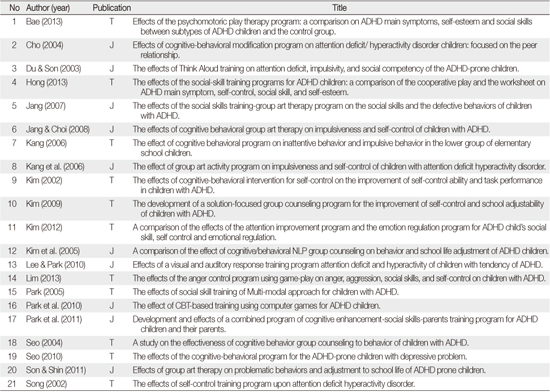
Quality Assessment of Studies Included in Meta-Analysis
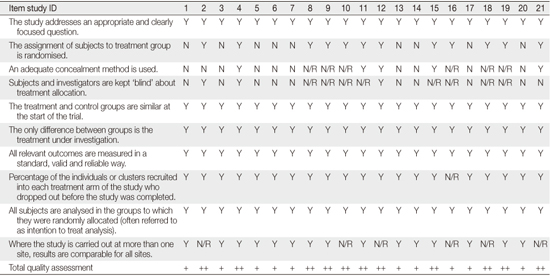
Descriptive Summary of Included Studies
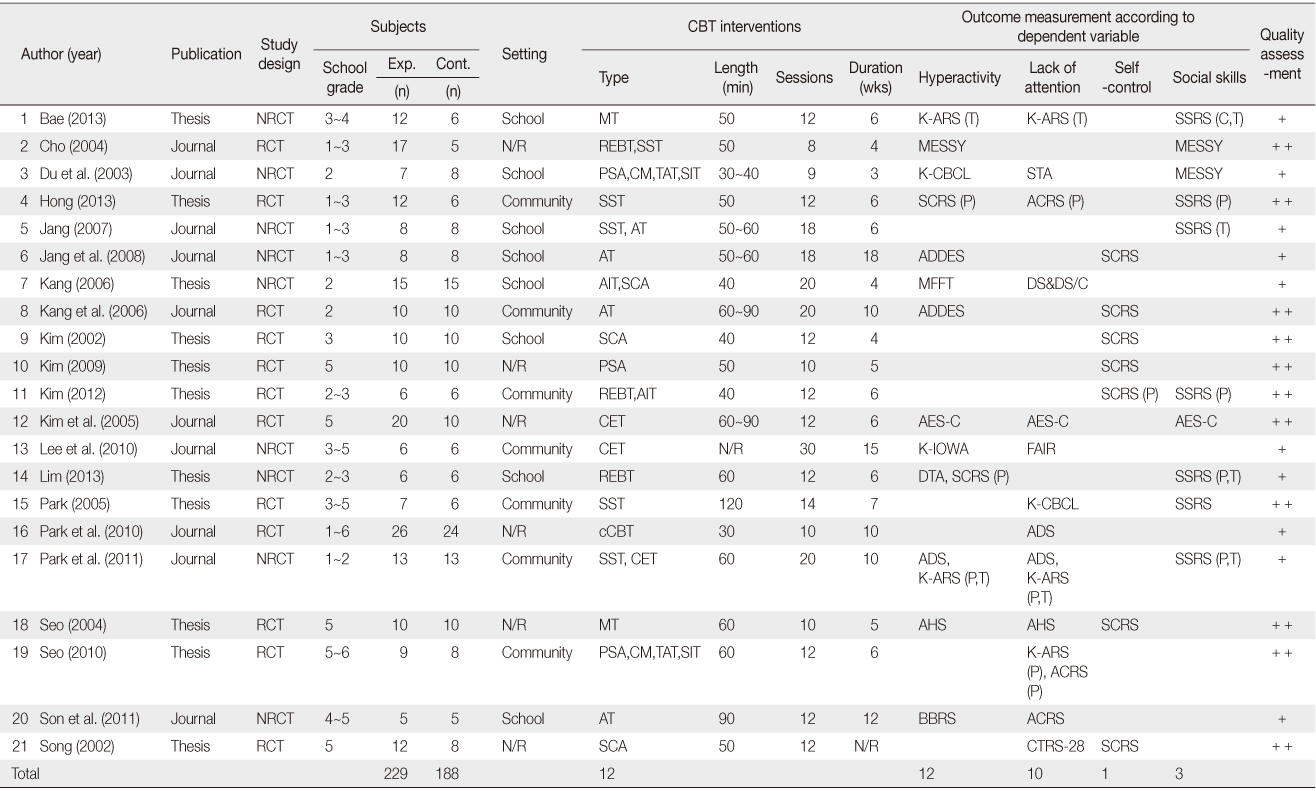
RCT=Randomized controlled trials; NRCT=Non-randomized controlled trials; N/R=Not reported; SST=Social skill training; REBT=Rational emotive behavioural therapy; SCA=Self control approaches; PSA=Problem solving approaches; CM=Cognitive modeling; cCBT=Delivery of computerised CBT; MT=Multimodal therapy; AIT=Attention improved training; TAT=Think aloud training; SIT=Self instructional training; AT=Art therapy; CET=Cognitive enhancement training; ACRS=Abbreviated conners parent-teacher rating scale-revised; ADDES=The attention deficit disorders evaluation scale; ADS=ADHD diagnostic system; AES-C=Attention deficit hyperactivity disorder evaluation scale-children version; AHS=Attention deficit and hyperactivity rating scale; BBRS=Burks behavior rating scales; DTA=Diagnostic test of aggression; CTRS-28=Conners teacher rating scale-28; DS&DS/C=Digit span of K-WISC-III & digit symbol/coding; FAIR=Frankfurter aufmerksamkeits-inventar; K-ARS=Korean-ADHD Rating scale; K-CBCL=Korean-child behavior checklist; K-IOWA=Korean-IOWA conners rating scale; MESSY=Matson evaluation of social skills with youngsters; MFFT=Matching Familiar figures test; SCRS=Self-control rating scale; SSRS=Social skills rating system; STA=Stratified test of attention; P=Parent; T=Teacher; C,T=Children, teacher.
Figure & Data
REFERENCES
Citations

- CBT, parent training, and combined approaches for children with ADHD: A randomized study
Burcu Hafiz Ahmet, Alperen Bıkmazer, Vahdet Gormez
Psychology and Psychotherapy: Theory, Research and Practice.2025;[Epub] CrossRef - Towards Understanding the Effect of Serious Games on Attention, Adherence, and Behavior for Children with ADHD
Jonathan Wang Liu, Mahmood Jasim, Jeong-Heon Song, So-Hwi Ha, Junsu Kim, Da young Kim, Hyunsuk Lee, Byeongil Kim, Hee-Tae Jung
ACM Transactions on Computer-Human Interaction.2025;[Epub] CrossRef - Effectiveness of sensory integration therapy in children, focusing on Korean children: A systematic review and meta-analysis
Seri Oh, Jong-Sik Jang, A-Ra Jeon, Geonwoo Kim, Mihwa Kwon, Bahoe Cho, Narae Lee
World Journal of Clinical Cases.2024; 12(7): 1260. CrossRef - Trends in South Korean Medical Device Development for Attention-Deficit/Hyperactivity Disorder and Autism Spectrum Disorder: Narrative Review
Yunah Cho, Sharon L Talboys
JMIR Biomedical Engineering.2024; 9: e60399. CrossRef - Self-management training vs. neurofeedback interventions for attention deficit hyperactivity disorder: Results of a randomized controlled treatment study
Ann-Kathrin Korfmacher, Oliver Hirsch, Mira-Lynn Chavanon, Björn Albrecht, Hanna Christiansen
Frontiers in Psychiatry.2022;[Epub] CrossRef - Effects of hippotherapy on children with cerebral palsy: systematic review and meta-analysis
Kwon-Hoi Kim, Suk-Min Lee
Physical Therapy Rehabilitation Science.2020; 9(1): 55. CrossRef - Effect of aquatic exercise on gait in persons with chronic stroke: a meta-analysis study in Korea
Dong-Jin Lee, Sung-Hyoun Cho
Physical Therapy Rehabilitation Science.2019; 8(2): 112. CrossRef - Risk and protective factors for the development of ADHD symptoms in children and adolescents: Results of the longitudinal BELLA study
Anne Wüstner, Christiane Otto, Robert Schlack, Heike Hölling, Fionna Klasen, Ulrike Ravens-Sieberer, Kenji Hashimoto
PLOS ONE.2019; 14(3): e0214412. CrossRef - A Meta Analysis on Variables related to Death Anxiety of Elderly in Korea
Sinhyang Kim, Kyung Sook Park
Korean Journal of Adult Nursing.2016; 28(2): 156. CrossRef - A Meta-analysis of Intervention Studies on the Effects of Self Management and Education in Adult Asthmatic Patients
Chae-Bong Kim, Min-Kyung Han, Mi-Seon Jeong, Bo-Young Choi, Kil-Yong Choi, Moo-Young Kim
The Korean Journal of Health Service Management.2015; 9(3): 175. CrossRef - Effects of a Social Skills Training Program on Problem Behaviors, Social Skill, and Peer Relationship in Children using a Community Child Center at Vulnerable Area
Myeong-Hui Choe, Yong-Mi Lee
Journal of Korean Academy of Psychiatric and Mental Health Nursing.2015; 24(3): 156. CrossRef - Clinical Application of the Korean Personality Rating Scale for Children in Attention-Deficit Hyperactivity Disorder
Woon Yoon, Kee-Jeong Park, Kukju Kweon, Hyo-Won Kim
Journal of the Korean Academy of Child and Adolescent Psychiatry.2015; 26(3): 217. CrossRef
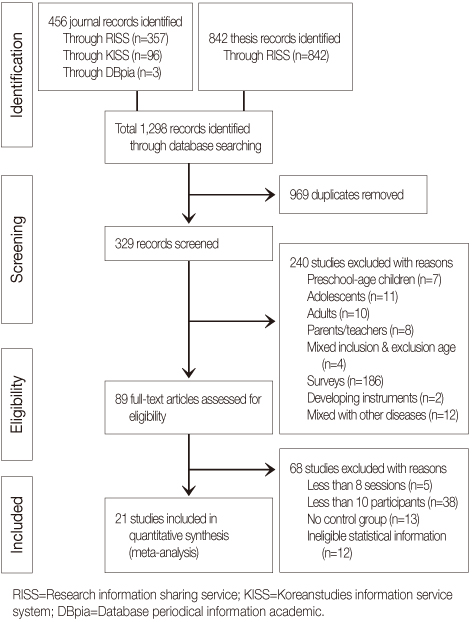

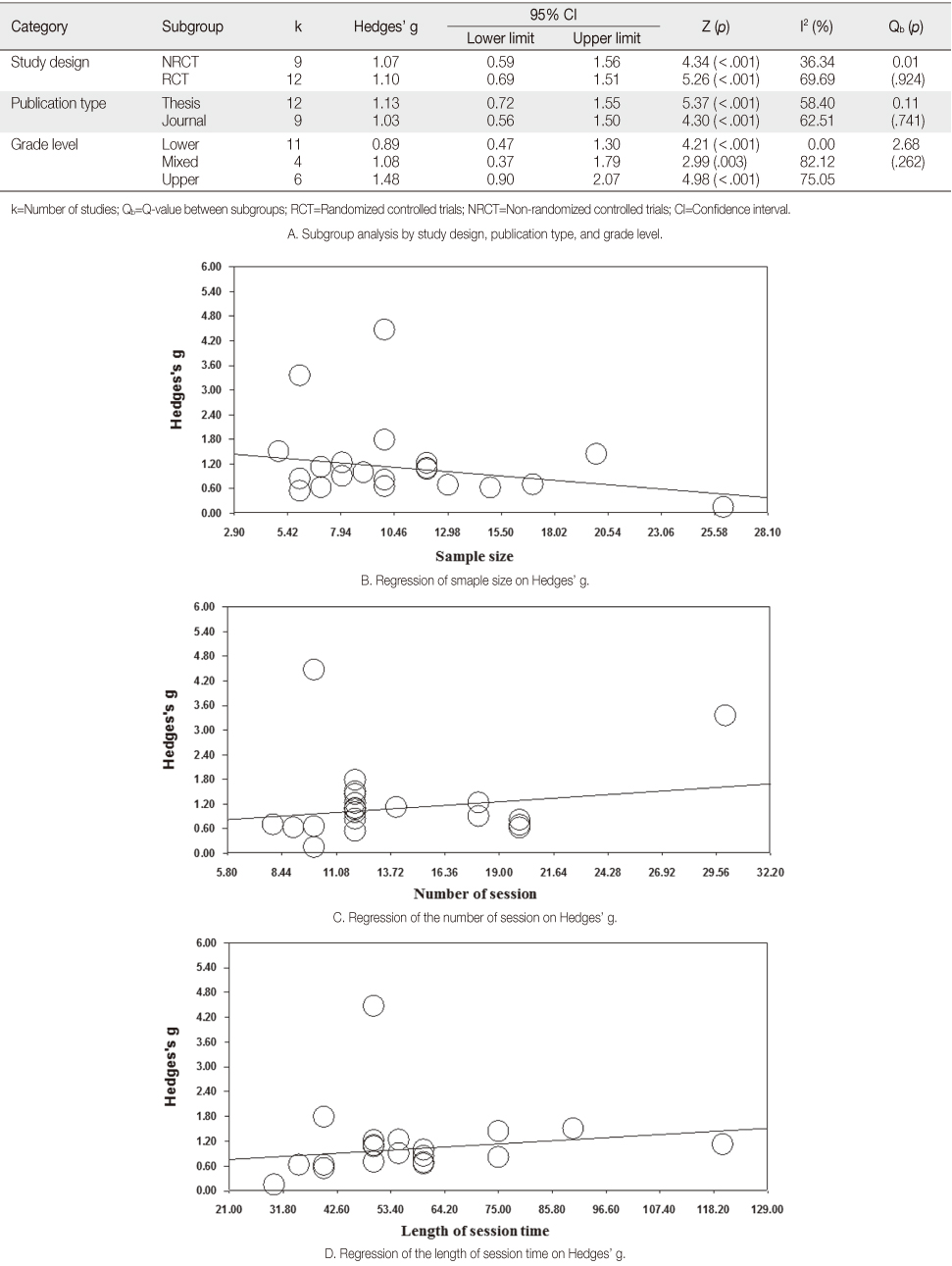
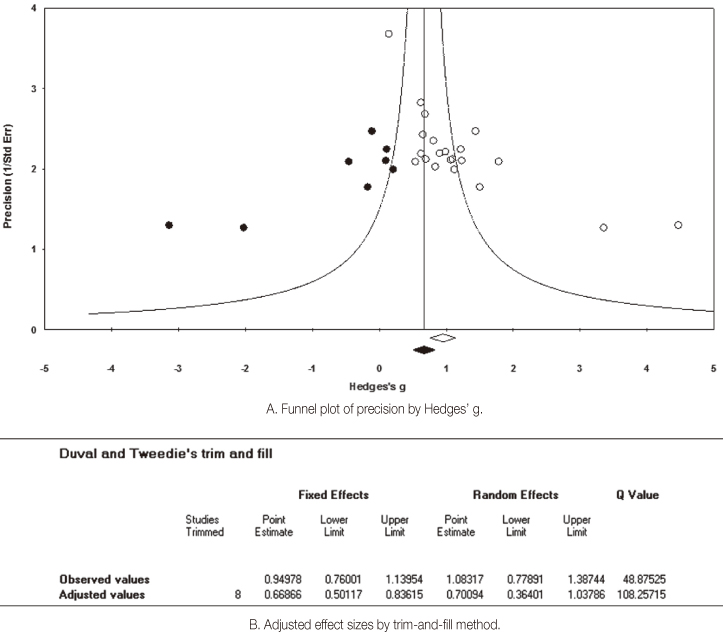
Figure 1
Figure 2
Figure 3
Figure 4
Descriptive Summary of Included Studies
RCT=Randomized controlled trials; NRCT=Non-randomized controlled trials; N/R=Not reported; SST=Social skill training; REBT=Rational emotive behavioural therapy; SCA=Self control approaches; PSA=Problem solving approaches; CM=Cognitive modeling; cCBT=Delivery of computerised CBT; MT=Multimodal therapy; AIT=Attention improved training; TAT=Think aloud training; SIT=Self instructional training; AT=Art therapy; CET=Cognitive enhancement training; ACRS=Abbreviated conners parent-teacher rating scale-revised; ADDES=The attention deficit disorders evaluation scale; ADS=ADHD diagnostic system; AES-C=Attention deficit hyperactivity disorder evaluation scale-children version; AHS=Attention deficit and hyperactivity rating scale; BBRS=Burks behavior rating scales; DTA=Diagnostic test of aggression; CTRS-28=Conners teacher rating scale-28; DS&DS/C=Digit span of K-WISC-III & digit symbol/coding; FAIR=Frankfurter aufmerksamkeits-inventar; K-ARS=Korean-ADHD Rating scale; K-CBCL=Korean-child behavior checklist; K-IOWA=Korean-IOWA conners rating scale; MESSY=Matson evaluation of social skills with youngsters; MFFT=Matching Familiar figures test; SCRS=Self-control rating scale; SSRS=Social skills rating system; STA=Stratified test of attention; P=Parent; T=Teacher; C,T=Children, teacher.
RCT=Randomized controlled trials; NRCT=Non-randomized controlled trials; N/R=Not reported; SST=Social skill training; REBT=Rational emotive behavioural therapy; SCA=Self control approaches; PSA=Problem solving approaches; CM=Cognitive modeling; cCBT=Delivery of computerised CBT; MT=Multimodal therapy; AIT=Attention improved training; TAT=Think aloud training; SIT=Self instructional training; AT=Art therapy; CET=Cognitive enhancement training; ACRS=Abbreviated conners parent-teacher rating scale-revised; ADDES=The attention deficit disorders evaluation scale; ADS=ADHD diagnostic system; AES-C=Attention deficit hyperactivity disorder evaluation scale-children version; AHS=Attention deficit and hyperactivity rating scale; BBRS=Burks behavior rating scales; DTA=Diagnostic test of aggression; CTRS-28=Conners teacher rating scale-28; DS&DS/C=Digit span of K-WISC-III & digit symbol/coding; FAIR=Frankfurter aufmerksamkeits-inventar; K-ARS=Korean-ADHD Rating scale; K-CBCL=Korean-child behavior checklist; K-IOWA=Korean-IOWA conners rating scale; MESSY=Matson evaluation of social skills with youngsters; MFFT=Matching Familiar figures test; SCRS=Self-control rating scale; SSRS=Social skills rating system; STA=Stratified test of attention; P=Parent; T=Teacher; C,T=Children, teacher.
 KSNS
KSNS
 E-SUBMISSION
E-SUBMISSION

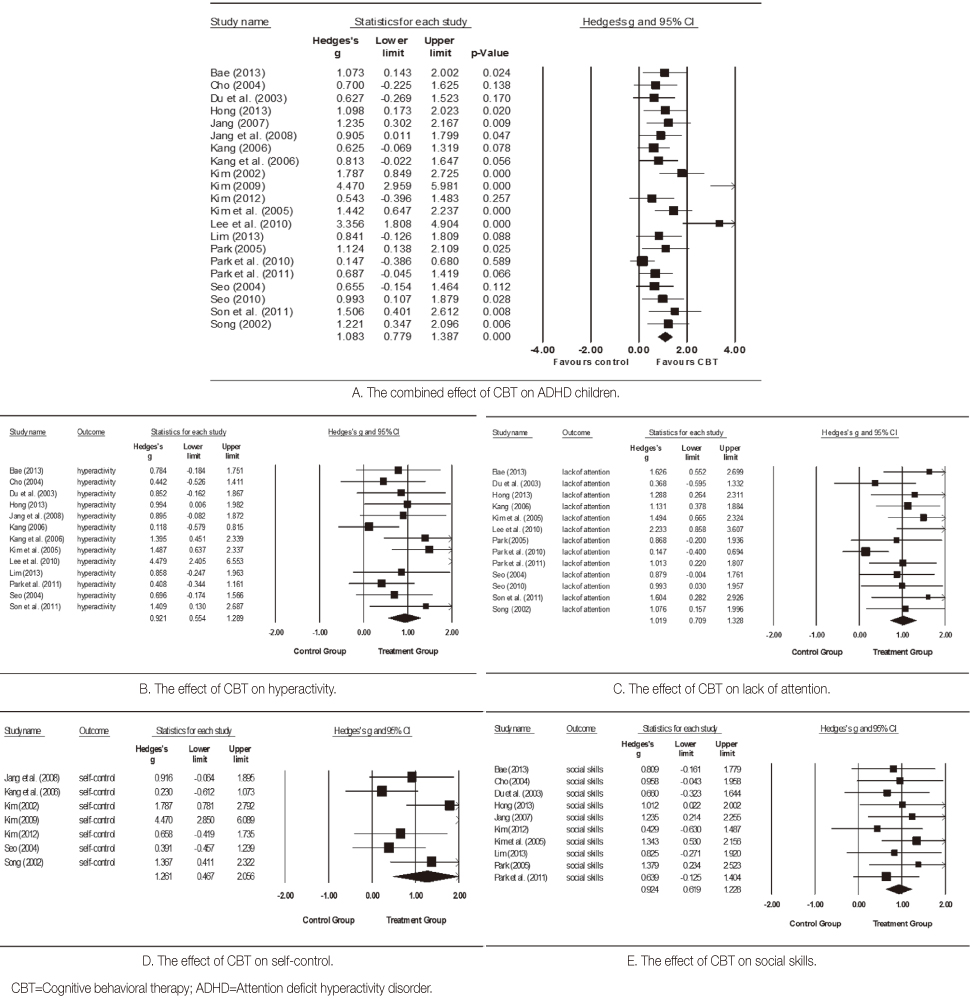


 Cite
Cite

